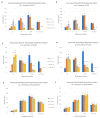The Anticancer Agent Elesclomol Has Direct Effects on Mitochondrial Bioenergetic Function in Isolated Mammalian Mitochondria
- PMID: 31344923
- PMCID: PMC6724019
- DOI: 10.3390/biom9080298
The Anticancer Agent Elesclomol Has Direct Effects on Mitochondrial Bioenergetic Function in Isolated Mammalian Mitochondria
Abstract
Elesclomol ((N-malonyl-bis(N'-methyl-N'-thiobenzoylhydrazide)); formerly STA-4783) is a mitochondria-targeted chemotherapeutic agent that has demonstrated efficacy in selective cancer cell killing in pre-clinical and clinical testing. The biologically active form of elesclomol is a deprotonated copper chelate (elesclomol:copper; E:C), which has been shown to enhance reactive oxygen species (ROS) production and induce a transcriptional gene profile characteristic of an oxidative stress response in vitro. Previous studies suggest that E:C interacts with the electron transport chain (ETC) to generate high levels of ROS within the organelle and ultimately induce cell death. The purpose of this study was to further explore the mechanism of cellular and mitochondrial toxicity of E:C by examining its direct effect on mitochondrial bioenergetic function. The results obtained indicate that E:C treatment in whole cells of non-tumorigenic origin at high concentrations (40 M and higher) induces a rapid and substantial increase in mitochondrial superoxide levels and dissipation of mitochondrial membrane potential. Furthermore, similar higher concentrations of E:C act as a direct uncoupler of oxidative phosphorylation and generalized inhibitor of electron transport activity in isolated, intact mitochondria, and induce a dose-dependent inhibition of mitochondrial NADH-ubiquinone oxidoreductase activity in freeze-thawed mitochondrial preparations. The results of this study are important in that they are the first to demonstrate a direct effect of the E:C chelate on bioenergetic function in isolated mammalian mitochondria, and suggest the possibility that the increase in ROS production and cytotoxicity induced by E:C may in part be due to uncoupling of mitochondrial oxidative phosphorylation and/or inhibition of electron transport activity. These results also provide important information about the mechanisms of mitochondrial and cellular toxicity induced by E:C and will ultimately contribute to a better understanding of the therapeutic potential of elesclomol as an anticancer compound.
Keywords: anti-cancer; bioenergetics; elesclomol; mitochondria.
Conflict of interest statement
The authors declare no conflict of interest.
Figures







Similar articles
-
The oncology drug elesclomol selectively transports copper to the mitochondria to induce oxidative stress in cancer cells.Free Radic Biol Med. 2012 May 15;52(10):2142-50. doi: 10.1016/j.freeradbiomed.2012.03.017. Epub 2012 Apr 17. Free Radic Biol Med. 2012. PMID: 22542443
-
Mitochondrial electron transport is the cellular target of the oncology drug elesclomol.PLoS One. 2012;7(1):e29798. doi: 10.1371/journal.pone.0029798. Epub 2012 Jan 11. PLoS One. 2012. PMID: 22253786 Free PMC article.
-
Pro-oxidant mitochondrial matrix-targeted ubiquinone MitoQ10 acts as anti-oxidant at retarded electron transport or proton pumping within Complex I.Int J Biochem Cell Biol. 2009 Aug-Sep;41(8-9):1697-707. doi: 10.1016/j.biocel.2009.02.015. Epub 2009 Mar 3. Int J Biochem Cell Biol. 2009. PMID: 19433311
-
Human NADH:ubiquinone oxidoreductase deficiency: radical changes in mitochondrial morphology?Am J Physiol Cell Physiol. 2007 Jul;293(1):C22-9. doi: 10.1152/ajpcell.00194.2006. Epub 2007 Apr 11. Am J Physiol Cell Physiol. 2007. PMID: 17428841 Review.
-
Novel insights into anticancer mechanisms of elesclomol: More than a prooxidant drug.Redox Biol. 2023 Nov;67:102891. doi: 10.1016/j.redox.2023.102891. Epub 2023 Sep 17. Redox Biol. 2023. PMID: 37734229 Free PMC article. Review.
Cited by
-
Potential biomarkers and targets of mitochondrial dynamics.Clin Transl Med. 2021 Aug;11(8):e529. doi: 10.1002/ctm2.529. Clin Transl Med. 2021. PMID: 34459143 Free PMC article. Review.
-
Elesclomol, a copper-transporting therapeutic agent targeting mitochondria: from discovery to its novel applications.J Transl Med. 2023 Oct 20;21(1):745. doi: 10.1186/s12967-023-04533-5. J Transl Med. 2023. PMID: 37864163 Free PMC article. Review.
-
An up-To-Date Review of Elesclomol and Its Nano-Formulations in Cancer Therapy.Cancer Rep (Hoboken). 2025 Apr;8(4):e70193. doi: 10.1002/cnr2.70193. Cancer Rep (Hoboken). 2025. PMID: 40195280 Free PMC article. Review.
-
Mitochondrial ROS drive resistance to chemotherapy and immune-killing in hypoxic non-small cell lung cancer.J Exp Clin Cancer Res. 2022 Aug 11;41(1):243. doi: 10.1186/s13046-022-02447-6. J Exp Clin Cancer Res. 2022. PMID: 35953814 Free PMC article.
-
Elesclomol: a copper ionophore targeting mitochondrial metabolism for cancer therapy.J Exp Clin Cancer Res. 2022 Sep 12;41(1):271. doi: 10.1186/s13046-022-02485-0. J Exp Clin Cancer Res. 2022. PMID: 36089608 Free PMC article. Review.
References
-
- Wangpaichitr M., Wu C., You M., Maher J.C., Dinh V., Feun L.G., Savaraj N. N′1,N′3-Dimethyl-N′1,N′3-bis(phenylcarbonothioyl) Propanedihydrazide (Elesclomol) Selectively Kills Cisplatin Resistant Lung Cancer Cells through Reactive Oxygen Species (ROS) Cancers. 2009;1:23–38. doi: 10.3390/cancers1010023. - DOI - PMC - PubMed
-
- Chen S., Sun L., Koya K., Tatsuta N., Xia Z., Korbut T., Du Z., Wu J., Liang G., Jiang J., et al. Syntheses and antitumor activities of N’(1), N’(3)-dialkyl-N’(1), N’(3)-di-(alkylcarbonothioyl) malonohydrazide: The discovery of elesclomol. Bioorg. Med. Chem. Lett. 2013;23:5070–5076. doi: 10.1016/j.bmcl.2013.07.032. - DOI - PubMed
-
- Berkenblit A., Eder J.P., Jr., Ryan D.P., Seiden M.V., Tatsuta N., Sherman M.L., Dahl T.A., Dezube B.J., Supko J.G. Phase I Clinical Trial of STA- 4783 in Combination with Paclitaxel in Patients with Refractory Solid Tumors. Clin. Cancer Res. 2007;13:584–590. doi: 10.1158/1078-0432.CCR-06-0964. - DOI - PubMed
-
- Korn E.L., Liu P.Y., Lee S.J., Chapman J.A., Niedzwiecki D., Suman V.J., Moon J., Sondak V.K., Atkins M.B., Eisenhauer E.A., et al. Meta-analysis of Phase II Cooperative Group Trials in Metastatic Stage IV Melanoma to Determine Progression-free and Overall Survival Benchmarks for Future Phase II Trials. J. Clin. Oncol. 2008;26:527–534. doi: 10.1200/JCO.2007.12.7837. - DOI - PubMed
Publication types
MeSH terms
Substances
LinkOut - more resources
Full Text Sources
Miscellaneous

